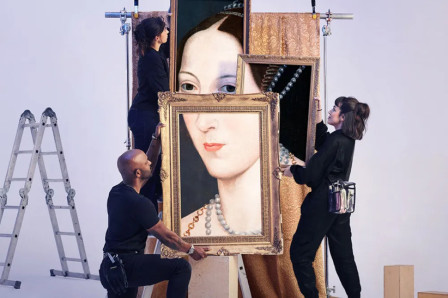Review: A TRIBUTE TO DALIDA at Peacock Theatre
The overwhelming majority of UK citizens will not have heard of Iolanda Cristina Gigliotti better known as multi-lingual singer Dalida who was born in 1933 to Italian parents based at Cairo, Egypt, where her violinist father died of a brain abscess when she was 12. As the show recounts, it was the first of many tragedies in the short life of the chanteuse, which eventually led to her committing suicide in 1987.
 A Tribute to Dalida, Peacock Theatre
A Tribute to Dalida, Peacock Theatre
I first encountered Dalida some 20 years ago, but lack of wider UK recognition is somewhat surprising given Dalida’s 30 year multi-lingual recording career (mainly in French and Arabic). Although estimates of her worldwide record sales vary wildly, most suggest numbers well in excess of 140million sales.
The show itself which stars French-Lebanese singer Mikayella Stephan, is a potted history of Dalida’s early beginnings, including her move to Paris after winning the Miss Egypt contest in 1954. Juxtaposed with verbally recounted factual milestones, are projected images of lovers including a young student Luigi Tenco with whom she became pregnant and then infertile due to abortion complications. He shot himself in 1967 after his entry for the San Remo Festival failed to reach the finals. Her intermittent lover French movie star Alain Delon also makes an appearance in several images, together with Dalida’s first husband Lucien Morrise. He had been the Europe 1 radio station programme director who made her famous by playing her 1956 record Bambino several times a day. It wasn’t until 5 years after they met that he was able to divorce his first wife and marry Dalida, but they divorced less than a year later after she took another lover. There were even rumours that she had an affair with François Mitterrand who later became French President, but this is among a number of revelations which are not mentioned during the show, which focuses largely on possibly a dozen songs from her back catalogue.
Nada Sabat’s selective homage, as directed by Sam Rayner, deploys a frankly interminable photo album motif to fill the narrative gaps, with statements of melodramatic hyperbole presumably taken from passages of biography or interviews in which the woman whose life was filled with “lovers who didn’t stay” decries their departure. What the show neglects to question, are the motives and reasons for their departure, or why despite the glamour and celebrity, she was a pitiably sad and lonely woman at the time of her suicide. Perhaps it is beholden on the audience to question whether those closest to her, tired of the self obsession, and the star’s all-consuming need to be loved and in the spotlight.
The audience of mixed nationalities (but all of a certain age) suggested that Dalida’s Euro-mystique retains a loyal following nearly 40 years since her death. They delighted in the half dozen costume changes which included a wardrobe malfunction (covered unsubtly by the 4 supporting dancers) and a feather boa which had seen better days. The support dancers Cameron Everitt, Alicia Mencia Lopez, Leroy Boone and Holly Saw all manage to adequately execute Christopher Tendai’s choreographic move, but often with their own distracting pops, flourishes and excessive facial expressions — which were particularly noticeable during the tango and lamentably overwrought tearing of the photo album sequence. Sometimes a less-is-more approach from the chorus, would benefit the overall impact and save comparisons with cruise ship entertainment.
With support of a six-piece onstage band under Tarik Saeed’s direction (including Rachid Zaidane’s notable percussion contribution), the crowd pleasers included Laissez-moi danser, Salma Ya Salama and Dalida’s French version of Mary Hopkins’ Those Were The Days. But Ms Stephan came unstuck with Mourir sur scène where both pitching and power were an issue.
I leave you with Dalida’s final words written following the death of her beloved Bulldog: “La vie m’est insupportable. Pardonnez-moi” (Life is unbearable for me… Forgive me).
Latest News

 StarKid announces West End run for 2026
17 November 2025 at 10:26
StarKid announces West End run for 2026
17 November 2025 at 10:26

 Almeida Theatre's 1536 to transfer to the West End
17 November 2025 at 09:46
Almeida Theatre's 1536 to transfer to the West End
17 November 2025 at 09:46

 GERRY AND SEWELL to transfer to the West End
14 November 2025 at 10:02
GERRY AND SEWELL to transfer to the West End
14 November 2025 at 10:02

 Rehearsal images released for HMS PINAFORE starring Mel Giedroyc
14 November 2025 at 09:29
Rehearsal images released for HMS PINAFORE starring Mel Giedroyc
14 November 2025 at 09:29
